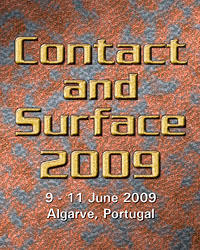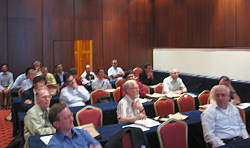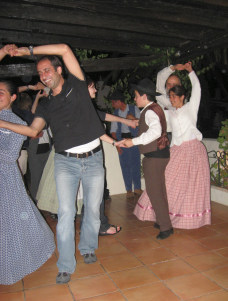Ninth International Conference on Surface Effects and Contact Mechanics - Computational Methods and Experiments
Algarve, Portugal
Overview & Opening Address
 The 9th International Conference on Surface Effects and Contact Mechanics was recently held in the Algarve, Portugal, organised by the Wessex Institute of Technology (WIT). The Chairmen were Professor Jeff De Hosson from Groningen University, the Netherlands, and Professor Carlos Brebbia from WIT, UK.
The 9th International Conference on Surface Effects and Contact Mechanics was recently held in the Algarve, Portugal, organised by the Wessex Institute of Technology (WIT). The Chairmen were Professor Jeff De Hosson from Groningen University, the Netherlands, and Professor Carlos Brebbia from WIT, UK.Previous conferences in the series were organised in Southampton (1993), Milano (1995), Oxford (1997), Assisi (1999), Seville (2001), Crete (2003), Bologna (2005) and at WIT’s Campus in the New Forest in 2007.
The series is aimed at encouraging international collaboration among the participants and the exchange of new ideas. The topics deal with the interplay between applied physics, material sciences, computational mechanics and mechanical engineering.
Professor De Hosson explained that, to an increasing degree, the search is for surface modification techniques which can increase the wear and corrosion of materials. Unfortunately, there exists an almost bewildering choice of surface treatments that cover a wide range of thickness. Professor De Hosson explained that it is worth noting that wear resistance is a property, not of materials, but of systems, since the material of the work piece always wears against some other medium. It is its relation to its environment – lubrication, speed of sliding/rotation – that determines the wear and corrosion resistance of the material in a given construction. The characteristics of the system, i.e. whether the wear is caused by delamination or abrasion determine, in Professor De Hosson’s words, which specific engineering methods should be chosen. The combination of surface treatment and contact mechanics is essential for the proper understanding of these problems.
Conference Sessions
Various developments were highlighted during the conference, both from the experimental and computational viewpoint. Special emphasis was given to the application of advanced theoretical and experimental approaches. Presentations were grouped into the following subject areas:
- Surface treatments
- Thick coatings
- Thin coatings
- Surface problems in contact mechanics
- Indentation and hardness
- Fatigue
- Numerical analysis
- Applications and case studies
Invited Papers
The programme included a series of invited presentations be well known colleagues:- “Dynamic smoothening and tribological properties of pulsed-DC sputtered DLC based nanocomposite films” by K.P. Shaha, University of Groningen, The Netherlands
- “Sliding mechanisms in tribological contact of TMD-C sputtered coatings” by A. Cavaleiro, University of Coimbra, Portugal
- “External surfaces affected by free hydrogen in metastable austenitic stainless steels” by Y. Katz, Negba Beer Sheva, Israel
- “Metallic laser clad coatings: on the processing-microstructure-property relationships” by V. Ocelík, University of Groningen, The Netherlands
- “Modification of rubber surface with DLC thin films for low friction and self lubrication” by Y.T. Pei, University of Groningen, The Netherlands
- “Generating behaviour of whiskers on Pb free Sn plating and its control” by Y. Kimura, Kogakuin University, Japan
- “Multi-scale FE analyses of sheet formability based on SEM-EBSD crystal texture measurement” by H. Sakamoto, Kumamoto University, Japan
International Scientific Advisory Committee
The Scientific Advisory Committee meeting which, as usual, took place over dinner, discussed ways in which the conference can continue to evolve in order to meet the needs of the international community. Several ideas were put forward regarding new topics and members of the committee. Special emphasis was put on the possibility of improving the conference contents and helping to disseminate its papers.
Conference Dinner
 The participants had numerous opportunities to meet in an informal way throughout the conference during coffee and lunch breaks and at dinner functions. This helped to create the right atmosphere.
The participants had numerous opportunities to meet in an informal way throughout the conference during coffee and lunch breaks and at dinner functions. This helped to create the right atmosphere.
The conference dinner took place in a restaurant renowned for its Portuguese cuisine. There the participants were able to taste a series of local delicacies, washed down by Duoro wines. Following that, a local folkloric group performed Algarve dances. The folklore of this region of Portugal is different from the rest of the country and is characterised by its fast pace and general feeling of joy and happiness. At the end of the performance, some of the participants demonstrated their energy and hidden talent by joining the dancers. At the end of the banquet, Professor Brebbia thanked the participants and gave them a gift as a reminder of the conference. This consisted of a piece of hand-made and hand-decorated pottery. The pieces are made as in the ancient past and the colours are those typical of pottery in this part of Europe, with a predominance of blue, green and yellow. The pottery was set up many years ago by a graduate from the Lisbon School of Arts, who wanted to produce pieces based on ancient traditions. Unfortunately, the number of authentic ceramic workshops continues to decrease in southern Europe, emphasising the importance of supporting remaining ones so as to retain their skills.
Registration Information
 The proceedings of “Surface Effects and Contact Mechanics IX: Computational Methods and Experiments”, 288pp (Print ISBN: 1-84564-186-3; Online ISBN: 1-84564-363-8; Print ISSN: 1746-4471) are available from WIT Press priced at £109/US$196/€138. Orders can be placed by telephone: +44 (0) 238 029 3223, fax: +44 (0) 238 029 2853, e-mail:
The proceedings of “Surface Effects and Contact Mechanics IX: Computational Methods and Experiments”, 288pp (Print ISBN: 1-84564-186-3; Online ISBN: 1-84564-363-8; Print ISSN: 1746-4471) are available from WIT Press priced at £109/US$196/€138. Orders can be placed by telephone: +44 (0) 238 029 3223, fax: +44 (0) 238 029 2853, e-mail: Papers from the conference will also be hosted online at the WIT eLibrary as Volume 62 of WIT Transactions on Engineering Sciences (Online ISSN: 1743-3533). For more details visit the WIT eLibrary at http://library.witpress.com.


 Wessex Institute
Wessex Institute